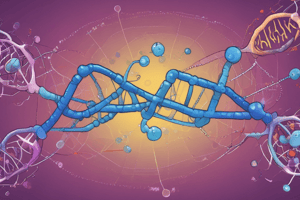Podcast
Questions and Answers
Which of the following events occurs during transcription? (Select all that apply)
Which of the following events occurs during transcription? (Select all that apply)
- mRNA binds to a ribosome in the cytoplasm.
- A cap is added to the RNA molecule.
- A molecule of RNA is formed based on the sequence of nucleotides in DNA. (correct)
- Those segments of the RNA strand that do not actually code for the protein are removed.
- The message in mRNA is translated into a protein.
Which of the following is a correct statement about mRNA? (Select all that apply)
Which of the following is a correct statement about mRNA? (Select all that apply)
- Segments of mRNA that code for protein are removed before translation.
- mRNA includes a cap that consists of extra adenine nucleotides.
- mRNA binds directly to amino acids during translation.
- mRNA moves from the nucleus to the cytoplasm following RNA processing. (correct)
- mRNA is transcribed from DNA in the cytoplasm.
The site of translation is
The site of translation is
- The cell nucleus.
- The Golgi apparatus.
- The plasma membrane.
- Ribosomes in the cell nucleus.
- Ribosomes in the cell cytoplasm. (correct)
Which one of the following does not play a role in translation?
Which one of the following does not play a role in translation?
Which of the following does not occur during RNA processing?
Which of the following does not occur during RNA processing?
Can one gene make different proteins?
Can one gene make different proteins?
In what way(s) can mRNAs be processed? (Select all that apply)
In what way(s) can mRNAs be processed? (Select all that apply)
Transcription factors control exon splicing.
Transcription factors control exon splicing.
Which genes are responsible for your overall structure, such as how many legs you have and where they develop?
Which genes are responsible for your overall structure, such as how many legs you have and where they develop?
DNA profiling relies on an individual's ________, no two of which are the same between different people, except identical twins.
DNA profiling relies on an individual's ________, no two of which are the same between different people, except identical twins.
Which of the following is an example of a transgenic organism?
Which of the following is an example of a transgenic organism?
Restriction enzymes __________________________.
Restriction enzymes __________________________.
The process of accurately amplifying a sample of DNA is called __________________________.
The process of accurately amplifying a sample of DNA is called __________________________.
Gel electrophoresis separates pieces of DNA based on _________.
Gel electrophoresis separates pieces of DNA based on _________.
A supplemental appendix is to a book as a ____________ is to a bacterial chromosome.
A supplemental appendix is to a book as a ____________ is to a bacterial chromosome.
Which of the following is FALSE? Finding a male calico cat is:
Which of the following is FALSE? Finding a male calico cat is:
Which of the following is FALSE regarding X-Chromosome inactivation?
Which of the following is FALSE regarding X-Chromosome inactivation?
Which of the following is NOT used in DNA ancestry?
Which of the following is NOT used in DNA ancestry?
Why is complementary DNA used in RNA sequencing?
Why is complementary DNA used in RNA sequencing?
Why do scientists measure gene expression?
Why do scientists measure gene expression?
Which of the following statements is FALSE regarding Okazaki fragments?
Which of the following statements is FALSE regarding Okazaki fragments?
What are Okazaki fragments?
What are Okazaki fragments?
Flashcards are hidden until you start studying
Study Notes
Transcription and Translation
- Transcription forms RNA based on DNA sequences; RNA nucleotides align with complementary DNA.
- mRNA, produced during transcription, moves from the nucleus to the cytoplasm after processing.
- The translation process occurs at ribosomes located in the cytoplasm.
- DNA does not directly participate in translation, as it provides the instructions for protein synthesis via RNA.
RNA Processing
- RNA processing involves adding adenine nucleotides (tail) and a modified guanine nucleotide (cap) to the RNA strand.
- Introns (non-coding regions) are removed from the mRNA, and exons (coding regions) are spliced together.
- Different protein isoforms can be created by altering how mRNA is spliced.
Genetic Function and Gene Expression
- Homeotic genes dictate an organism's overall form, such as limb development.
- DNA profiling relies on the unique short tandem repeats (STRs) within DNA that vary among individuals.
- Transgenic organisms contain genes from other species; for example, a bacterium with a human insulin gene.
Molecular Techniques
- Restriction enzymes specifically cut DNA at designated sequences, essential for DNA manipulation in biotechnology.
- The polymerase chain reaction (PCR) amplifies DNA samples for various genetic analyses.
- Gel electrophoresis sorts DNA pieces by size, enabling visualization of DNA fragments.
Chromosomal Features and Inheritance
- Plasmids represent supplemental genetic material in bacteria, akin to an appendix in books.
- Male calico cats can exist with an XXY genotype, making their occurrence rare but possible.
- X-chromosome inactivation results in one X chromosome becoming inactive in female mammals, influencing traits like calico coloring.
Genetic Testing and Ancestry
- Genetic ancestry testing utilizes Y chromosome and mitochondrial DNA, but typically not the X chromosome.
- Complementary DNA (cDNA) aids RNA sequencing by reflecting expressed genes in specific tissues and offering stability.
- Measuring gene expression is vital as it can vary in different cellular contexts and conditions.
DNA Replication Insights
- Okazaki fragments are produced on the lagging strand during DNA replication due to the antiparallel nature of DNA strands and are later joined by ligase.
- Misunderstanding occurs if one thinks Okazaki fragments are present on the leading strand, as they exclusively form in the lagging strand.
Studying That Suits You
Use AI to generate personalized quizzes and flashcards to suit your learning preferences.





